Something went wrong!
Hang in there while we get back on track
Best attractions in Matera

The Sassi di Matera are two districts of the Italian city of Matera, well-known for their ancient cave dwellings inhabited since over 7,000 (!) years. Called once the ‘Shame of Italy it is, after significant investment, now a popular tourist destination. It was in 2019 the European Capital of Culture and the location of Mel Gibson's "Passion of Christ" and the latest Bond film.

The "Palombaro Lungo" is the largest underground water cistern in the city of Matera and is located under the pavement of Piazza Vittorio Veneto, where rain and spring water from the hills of La Nera, Lapillo and Macamarda converge. With its solid pillars carved from the rock and a vault height of more than fifteen metres, it is a veritable water cathedral, which is navigable by boat. Like other cisterns in the town, it collected rainwater that was filtered and flowed in a controlled way to the Sassi. Together with other underground cisterns it forms the famous underground Matera. The Palombaro is approximately 18 meters high and 50 meters wide and has a capacity of approximately 5 million liters of water.


The majestic Cattedrale di Matera has been overlooking the old town since the 13th century, combining Romanesque-Apulian style on the outside with Baroque splendor on the inside. You will immediately notice the large rose window with 16 rays on the impressive facade, topped by a statue of the Archangel Michael.

The Casa Grotto di Vico Solitario is a captivating example of Matera's unique Sassi houses. With an entry fee of approximately 5 Euros, this small museum offers an immersive journey into the traditional life in Matera. It is an original cave dwelling furnished with traditional household items. Take half an hour to explore the 4 caves. There are written descriptions and an online audioguide available in various languages, which explain the context. The 1st cave contains the original cave dwelling house, the 2nd has a short movie about Matera's history, the 3rd is an old Church and the 4th one explains the water collection system.

The Murgia Materana Park, located between Matera and Montescaglioso in Basilicata, is a spectacular Italian landscape that beautifully encapsulates the ancient relationship between man and nature. Established in 1990, it features ravines, caves, and over 150 rock churches, showing the significant historical and cultural evolution from prehistoric times through the early Middle Ages. Among them are the Church of San Falcione with a beautiful fresco depicting “the presentation of Jesus at the temple” and church of Madonna delle Tre Porte, dating back to the 12th century, with frescos of great artistic and historical value. (located close to Matera in the "Park of Rock Churches") Notable are also San Leonardo, San Giacomo, Cappuccino vecchio and Santa Cesarea. The parks diverse flora and fauna, with approximately 1,200 botanical species and varied wildlife, make it an exceptional natural treasure.


Outside the city walls of Matera stands the Chiesa di San Giovanni Battista, the first sacred church built outside the city gates between 1230 and 1233. Its remarkable architecture combines Romanesque, Arab, Gothic, and Greek influences, especially evident in the richly decorated main portal adorned with plant motifs and animal sculptures. The three-nave interior is supported by eight intricately decorated columns and houses medieval chapels featuring a fresco of the Madonna della Nova from the 16th century, as well as a notable altarpiece by Vito Antonio Conversi from the mid-18th century.


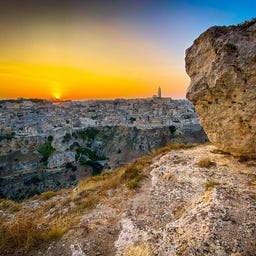
One of the best views in and around Matera. The viewpoint is located in the Murgia Materana Park (Park of Rock churches) across a deep gorge from the Sassi de Matera. With its spectacular panoramic view of Matera a visit is highly recommended. It is best enjoyed at sunrise or sunset when the light casts enchanting colors over the landscape.

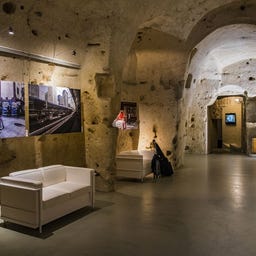
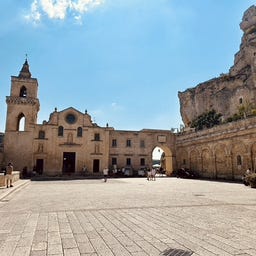
The Church of San Pietro Caveoso, a notable sight in Matera, dates back to the 12th century, embodying a significant part of the city's rupestrian heritage. Its facade, adorned with three portals topped by niches housing statues of the Madonna della Misericordia, Saint Paul, and Saint Peter, reflects a baroque influence. The church's interior reveals 15th- and 16th-century frescoes, a central nave concealed by a wooden false ceiling, and an 18th-century altar with a wooden polyptych from 1540. Despite its plundering during the 1960s and '70s when Matera faced abandonment, the church stands as a testament to the city's resilience. Recently, it has undergone consolidation to preserve its structure and historical significance.

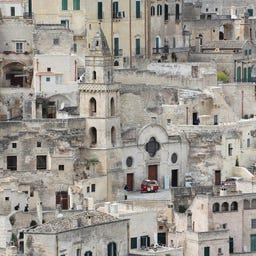
In the rocks of Matera, you will discover a fascinating network of medieval cave churches created by early monastic communities from Cappadocia, Armenia, and Syria as places of refuge. The rock-hewn sacred buildings combine Latin and Byzantine architectural elements and house impressive frescoes that still testify to the spiritual significance of these sites today.
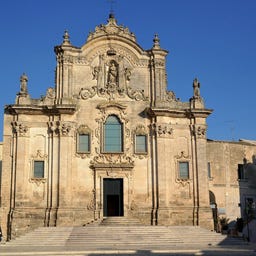
The Chiesa di San Francesco d'Assisi at the central Piazza San Francesco in Matera impressively connects different eras of the city's history. Originally built in the 13th century, the church received its current Baroque facade with the three distinctive statues - the Immaculate in the center, flanked by San Francesco and Sant'Antonio - in the 18th century.
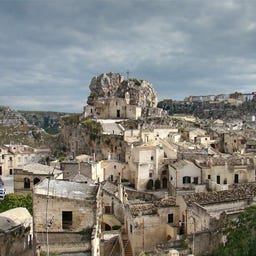
High above the Sasso Caveoso, the Chiesa di Santa Maria di Idris stands majestically, one of the most fascinating cave churches in Matera from the 12th century. Carved into the limestone, the church's name comes from the Greek "Odigitria" (Guide), and it impresses with its distinctive facade featuring a small bell tower. Inside, you’ll find 17th-century frescoes and a remarkable tempera painting of the Madonna and Child. An underground passage connects the church to the Crypt of San Giovanni in Monterrone, where you can admire Byzantine-influenced frescoes from several centuries.
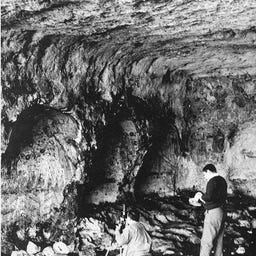
In the Gravina di Picciano near Matera, you will discover the Cripta del Peccato Originale, a church carved into the rock between the 8th and 9th centuries, which is also known as the "Sistine Chapel of rock churches" due to its impressive frescoes.
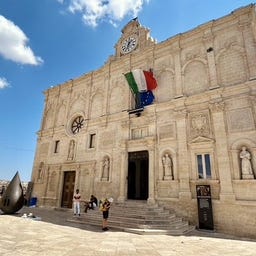
The impressive Palazzo Lanfranchi was built between 1668 and 1672 as a seminary in Baroque style and today connects the modern city with the historic Sassi districts. In this four-story building, characterized by its asymmetrical façade adorned with statues of saints and blind arcades, you will find the National Museum of Medieval and Modern Art of Basilicata since 2003. Here, you can look forward to not only significant collections of sacred and contemporary art but also an intriguing history: from 1864 to 1967, the Palazzo served as a high school where the famous poet Giovanni Pascoli even taught.
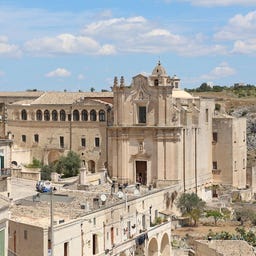
In the Sassi district of Matera, you will find the impressive Convento di Sant'Agostino, a complex of church and monastery built in 1592 by Augustinian monks on the foundations of an older sanctuary. This site, which survived a severe earthquake in 1734, once hosted the General Chapter of the Augustinian Order and now serves as the headquarters for the Italian heritage protection authority.
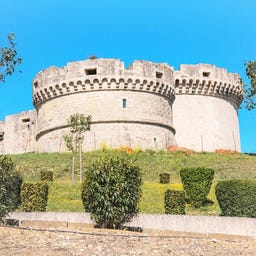
High above the old town of Matera stands the unfinished Castello Tramontano, which was built in the early 16th century by the feudal lord Giovan Carlo Tramontano as a residence. The fortress, constructed in the Aragonese style with its distinctive keep and two round towers, cost a staggering 25,000 ducats—a burden that was placed on the population through high taxes.
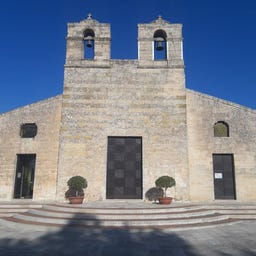
High above the valley of the Bradano River, at 440 meters between Basilicata and Apulia, you will find the Santuario della Madonna di Picciano - a spiritual gem near Matera. Originally founded in the 13th century by Benedictines, the church has been cared for by various orders over the centuries and took on its current three-nave Romanesque form in the late 18th century.
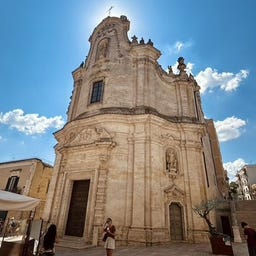
In the historic old town of Matera stands the Chiesa del Purgatorio, an impressive Baroque building from the 18th century, constructed between 1725 and 1747 by the Confraternita del Purgatorio.

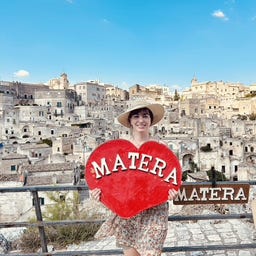
The views from the terrace in front of the Church of Santa Maria de Idris are worth the walk up.
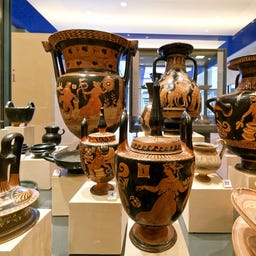
In the former Santa Chiara Monastery, you will find the oldest museum in the Basilicata region, which has been telling the archaeological history of Matera since 1911. The founder, Domenico Ridola, bequeathed his extensive collection to the state, which today takes you through five thematic rooms from the Paleolithic era to the Roman period.

In the rocks of Sasso Caveoso in Matera, you will discover the Chiesa di Santa Lucia alle Malve, an impressive cave church from the 11th century that was originally part of a Benedictine convent. The church, renamed from Sant'Agata to Santa Lucia between 1217 and 1267, captivates with its valuable 12th-century frescoes, including the remarkable depiction of the Archangel Gabriel and the Madonna del Latte. Above the asymmetrically designed rock church lies an ancient necropolis with tombs carved into the rock, while three intricately designed chalices on the facade symbolize the martyrdom of Santa Lucia.

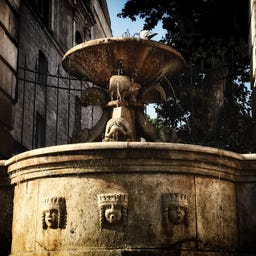
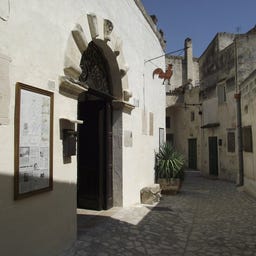
In the historic Sassi district of Matera, you will discover a fascinating ethnographic museum that offers authentic insights into the life of the former farming and artisan community. Founded by Donato Cascione and Barbara Eramo, the museum spans 500 square meters and features faithfully recreated workshops and typical living spaces, including a remarkable "Lamione" from the 16th century, integrated into an existing cave dwelling.
The Chiesa di San Rocco is one of the impressive rock churches in Matera, built in 1348. As part of the region's rich cultural heritage, it is closely linked to the monastery of the Reformed Fathers.
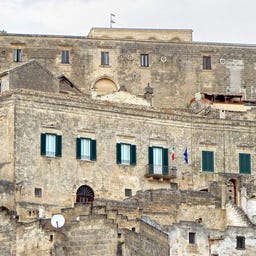
In the historic Palazzo Pomarici, which rises at the highest point of the famous Sassi di Matera, you will find MUSMA - a museum dedicated entirely to contemporary sculpture. Since its opening in 2006, it has housed around 270 artworks by 200 different artists, including significant pieces by Giacomo Manzù, Arnaldo Pomodoro, and Pietro Consagra. MUSMA uniquely combines the millennia-old architecture of Matera with modern sculpture, offering you a comprehensive insight into the Italian and international sculpture scene.

The baroque Chiesa di Santa Lucia stands in the historic center of Matera between Via del Corso and Piazza Vittorio Veneto, where it was built around 1700 after the relocation of a convent. A freshly restored staircase leads you up to the monumental baroque facade, right next to the historic Fontana Ferdinandea.

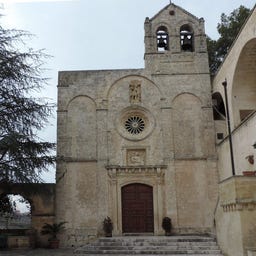
Perched on a rocky outcrop above the Gravina di Matera, the Santuario di Santa Maria della Palomba was built in 1580 on the foundations of an older cave church. The Romanesque facade captivates with its rose window and a statue of the Archangel Michael, while above the portal, you can see a depiction of the Holy Family created by Giulio Persio.

In the historic Palazzo del Sedile in Matera, you will find the Egidio Romualdo Duni Conservatory, the first music education institution in Basilicata. Initially established in 1965 as a branch of the Conservatory of Bari, it gained independence in 1969 under the leadership of Nino Rota.
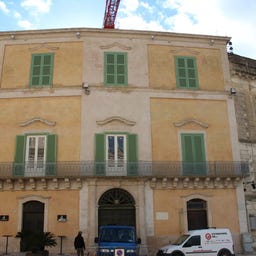
In the heart of the Sassi di Matera, the impressive Palazzo Malvinni-Malvezzi rises, a three-story noble palace from the 15th century that strikingly reflects the history of the city. When Matera became the capital of Lucania in 1663, the palace was generously expanded between the late 18th and early 19th centuries and adorned with a magnificent Baroque facade.

The impressive Palazzo dell'Annunziata at Piazza Vittorio Veneto has shaped the cityscape of Matera since the 18th century. Originally commissioned by Dominican nuns, construction began in 1735 but was only completed in 1844 under the direction of engineer Gaetano di Giorgio. After a tumultuous history, including serving as a courthouse and school, the Palazzo now houses the provincial library Biblioteca Tommaso Stigliani, which boasts a valuable collection of books and manuscripts. Following a comprehensive restoration after the 1980 earthquake, the building skillfully combines historical and modern elements.
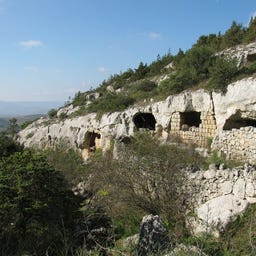
About 6 km southeast of Matera, you'll find the impressive cave settlement of Villaggio Saraceno in the Parco della Murgia Materana nature park. The approximately 70 caves carved into the rock, which served as shelters for shepherds and their flocks until the late 20th century, offer you an authentic glimpse into the early settlement of the region.

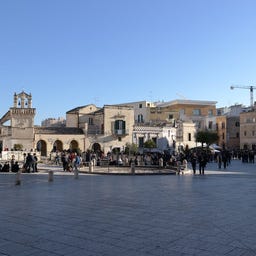
The Piazza Vittoria Veneto is the main starting point to explore the Sassi districts. It contains the tourist office, the Palombaro Lungo, a remarkable 15-meter-deep cistern, the viewpoint Belvedere Guerricchio, wonderful Palazzo's and churches.
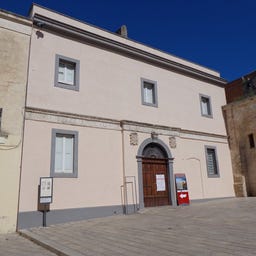
In the Chiesa del Cristo Flagellato, you will encounter a fascinating piece of history that has undergone many transformations since its construction in 1348 after a plague epidemic. Once known as the "Church of Artists," the chapel became part of a Franciscan monastery in the 17th century, later served as a prison, and even functioned as an air raid shelter during World War II.
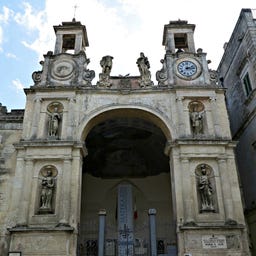
The impressive Palazzo del Sedile in the heart of Matera, with its Renaissance façade and distinctive bell towers, reflects its former significance as the seat of the city parliament in the Kingdom of Naples. Since its relocation to the foot of the city wall in 1575, the palace, adorned with intricate statues including figures of saints and the four cardinal virtues, has shaped the city's skyline.
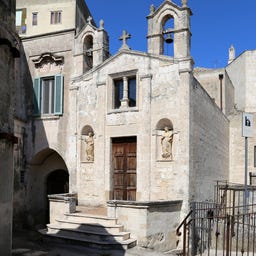
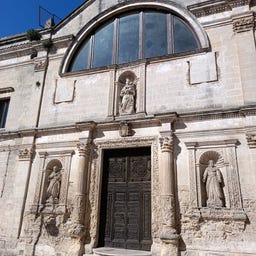
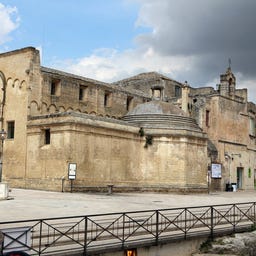
The impressive Chiesa di San Domenico has been standing since the 13th century at the central Piazza Vittorio Veneto in Matera and is one of the oldest Dominican monasteries in the region. The complex, founded by Nicola Paglia, captivates with its Romanesque façade featuring blind arches and a striking rose window, which displays a torch-bearing symbol of the Dominican order.
The "Cineteatro Duni" is a theater in Matera. It is named after Egidio Romualdo Duni, an 18th-century composer from Matera. It is the largest theater with the most seating in the Basilicata region.
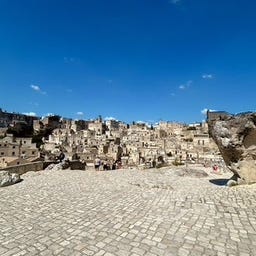
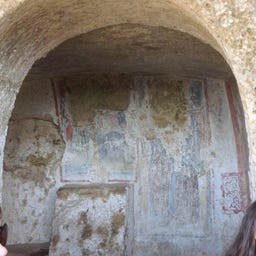
The church of the Madonna delle Tre Porte is so called because it is believed to have had three entrances carved into the rock. The sanctuary is a precious monument of underground art and history. Today this rock church reveals two naves adorned with ancient graffiti crosses and notable frescoes spanning from the 12th to the 17th century. Highlights include the Annunciation and a vividly painted Madonna of the Pomegranate, symbolizing life. The main apse is frescoed with a Deesis of Christ, with the Virgin and Saint John the Baptist kneeling at the sides. In the left nave, above the ambo, the Annunciation and a Madonna enthroned with Child are visible. The last fresco depicts the scene of the Crucifixion.
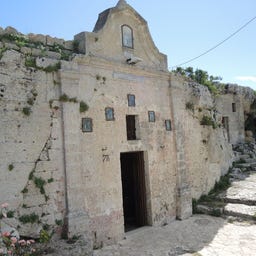
The "Madonna delle Vergini" is a rock church located in the Murgia Materana, on the opposite side of the Gravina stream compared to the Sassi of Matera.
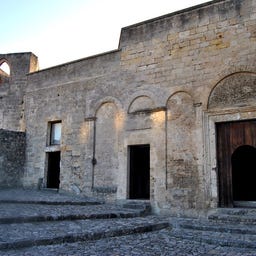
The "rock church of Santa Maria de Armenis" is a place of worship located within the Sassi of Matera.
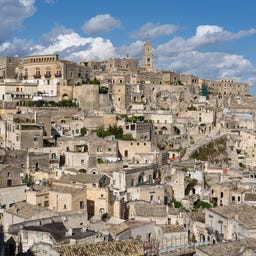
"Palazzo Bernardini," historically known as "Palazzo Ferraù" or "Giudicepietro," dominates the Sasso Caveoso of Matera.
"Palazzo Venusio" is one of the many noble palaces in Matera, located on S. Potito street.
"Palazzo Gattini" is a noble palace in Matera, where one of the emerging families of the Materan nobility resided: the Gattini counts. The palace is located in Piazza Duomo.
The "Church of Our Lady of Graces" is a rock church in Matera.
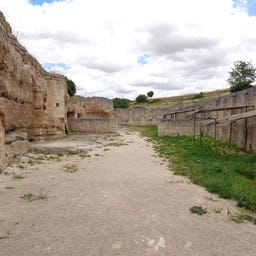
The "Church of San Falcione" is a rock-hewn church located in Matera.

"Palazzo Bronzini," located at the corner of Piazza Sedile and Via Duomo, was built a couple of centuries ago after the demolition of the church dedicated to Santa Sofia, which was home to two lay brotherhoods: that of the undertakers and that of San Crispino. M. Padula, "Historic Palaces of Matera," p. 129.
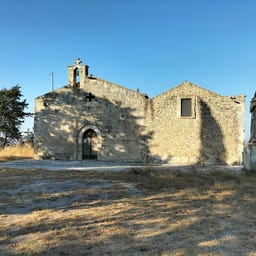
The "Church of San Salvatore," also known as the Sanctuary of God the Savior, is located in Timmari, a locality in the Municipality of Matera, about 13 km from the city center.
The church of "San Giovanni in Monterrone," founded between the 9th and 10th centuries, is an integral part of the complex of the Church of Santa Maria di Idris near the Sasso Caveoso.
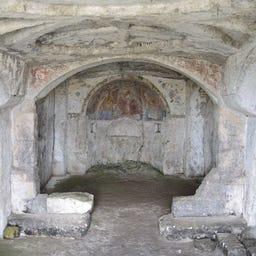
Carved into the rock face of Murgia Materana, you will find the Chiesa della Madonna della Croce from the 11th century - one of the impressive cave churches facing the Sassi di Matera. The two-chambered church gets its name from an equilateral cross carved into the ceiling and features a well-preserved fresco of the seated Madonna with Child in the apse.
In the rocks of Matera, you will discover the Cappella di San Giovanni, one of the characteristic cave churches of this southern Italian city. The simple, rectangular church space is covered by a flat ceiling supported by a central column.
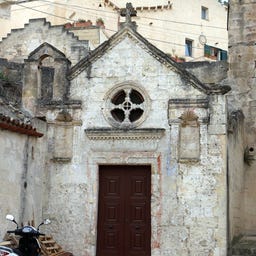
The church "Sant'Antonio Abate" is part of the complex of rock churches in Matera.
The "Church of Saint Agnes," also known as the "Church of Santa Maria dell'Arco," is a religious building located in Matera.
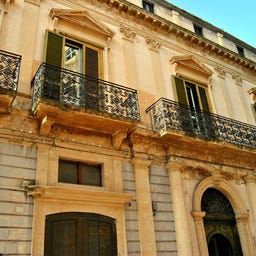
"Palazzo Ridola" is located at the beginning of Via Duomo, on the left side, opposite the tower that became Palazzo Vizziello. The first palatial residence had its entrance from Via Tre Corone. The structure had two levels: the residence of the Ridola family, which established itself in the second half of the 18th century, and a terrace decorated with statues that was demolished in 1860 as part of the expansion works of the palace, carried out with great skill, after which the entrance was moved to Via Duomo.
